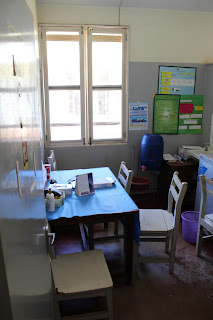It’s been too long.
We hope you have missed us?
Apologies for the delay in updating the blog, work has got the better of
us (like so many others)!
We promised to document the many differences in working as a
paediatrician in Jinja and so will try to do so. This is just a taster of the differences we
feel are most important.
Always ask for help
early!
When attending any resuscitation course in the UK one of the
first things you are taught is to shout for help early. In the resuscitation scenarios often the help
isn’t available. This makes for
excellent preparation. In the emergency
department in Jinja, there is no crash bleep (or any bleep for that matter) to
get people to come running. There’s only
you and the nurse (or student nurse).
Intubation does not exist. The airway is managed with a bag
and mask (mask singular – one size fits all).
The staff are not trained in neonatal or paediatric resuscitation, but
they will help if you tell them what to do.
Cannulation
A task almost exclusively performed by nurses in Uganda. And done to a level that puts me and every
paediatrician I know to shame. The
nurses are able to cannulate in the most extreme and difficult situations.
The hospital at night
 |
| Triage area- paediatric hospital |
There are no doctors.
None. The interns (doctors with
less than one year experience following medical school) leave the hospital around
20.00 and return at approximately 09.00.
During that period clinical officers (people who have undertaken a 3
year diploma to learn to treat common local conditions) clerk the new arrivals
whilst in-patients are cared for by the nurses.
In an emergency, the patient will be sent to ED and the nurse will be
responsible for initiating treatment. At
times the same situation is true in the day.
This is what happens when a hospital which covers a population of 2.5
million has only 6 doctors: three consultants (one of whom is out of the
region) and 3 intern doctors. Just to
put this in perspective, there are single children’s wards in the UK that have
more doctors than this for 20 patients!
Neonatal Intensive
care
A morning ward round at approximately 0900 in which all the
in-patients and post-natal ward babies are seen. No medical presence until the following
morning.
 |
| Special care unit- incubators and oxygen concentrator |
New admissions are seen and commenced on treatment that the
nurse decides. If the nurse is unable to get iv access for that child, then no
treatment is given until the doctor arrives the following morning. If there is
a power cut (which happens frequently) there is no oxygen and incubators do not
work.
A doctor trained in neonatal resuscitation does not attend
deliveries and would not be easily contactable even they could attend, as the
Children’s hospital is on a different site to the special care baby unit.
If a mother cannot afford to stay in hospital and cannot
feed herself, then she does not produce breast milk the baby does not get any;
this mother is also unable to buy formula.
 |
| Resuscitation area- special care unit |
There is no phototherapy available in Jinja. Bilirubin
levels are not checked, indeed blood tests are rarely taken at all. Treatment
of jaundice involves holding the baby near the window and hoping for the best.
 |
| Clinic room (2 desks) |
Clinics
Clinics have no maximum number and a ‘morning
clinic’ will often run on until 3pm because of the volume of patients to be
seen. The patients do not have a set appointment time- they simply attend on
that day and wait until they can be seen, which is often several hours. The
concept of ‘new patient’ or ‘follow up’ slots with allocated times is a distant
dream here. The time with each patient
is limited and so consultations have to be kept very short and to the
point. Clinicians have to share clinic
rooms as there is not enough space for each patient to be seen in a separate
room and therefore patient confidentiality is not achievable.More very soon....
Colin and Jess